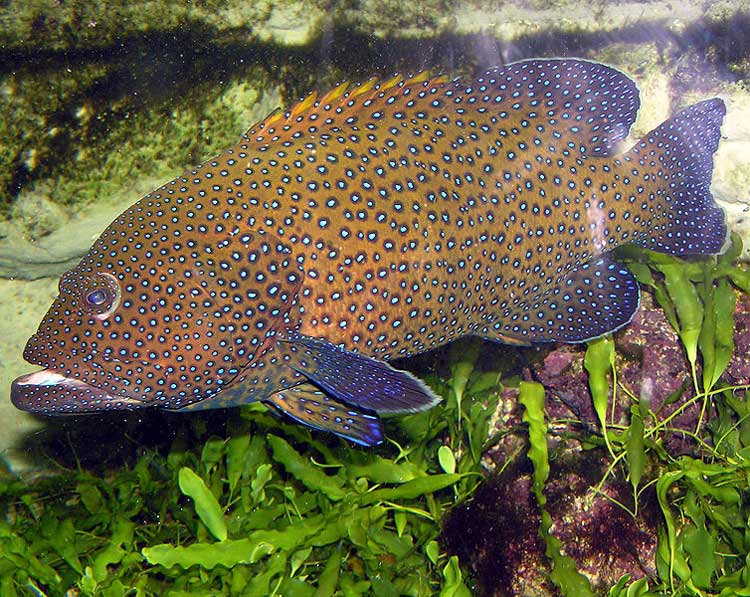Cephalopholis argus Cladus: Eukaryota Vernacular names Cephalopholis argus, also known as: Blue-spotted Grouper, Argus Grouper, Peacock Hind, Peacock Grouper or Peacock Rockcod is a fish from the Indo-Pacific which is variously a commercial gamefish, an invasive species and occasionally an aquarium resident. Its species name comes from its resemblance to the "hundred staring eyes" of the monster Argus in Greek mythology.
A medium sized fish that can reach a length of 60 centimeters (24 in). Small individuals are dark brown with hundreds of small, dark-edged iridescent blue spots. Larger specimens sometimes develop four to six lighter vertical bars on the back half of its body.[1] Behavior Roi typically sit on a coral head, retreating when startled.[1] Red Sea males defend harems of 2-6 females in territories ranging up to .5 acres (0.20 ha). Each female defends part of the territory from the other females. The male visits each female daily, raising his dorsal fin to signal his approach. The females emerges from hiding, erecting her own dorsal fin and changing to a lighter color. They swim together, rubbing flanks before he departs until the next day.[1] Territorial disputes may involve "color fights" in which two males positioning themselves at right angles to each other. They then darken their color and repeatedly switch their bars from dark to light. The loser becomes pale and retreats. If the color fight ends in a draw, the two males may attack each other.[1] Reproduction In Micronesia, spawning usually occurs territorially at dusk. During courtship, both sexes darken except for a white keyhole-shaped patch at the center of the body.[1] Ecology Feeding Hunting, they lie on the bottom and surge forward, preferring juvenile surgeonfish and crustaceans. Alternatively they may hover motionless in the water column before attacking.[1] This grouper may follow and cooperate with another predator species, such as an octopus or eel or camouflage themselves in a school of surgeonfish. Multiple individuals may cooperate to harass an eel to get it to flush prey for them.[1] In the Red Sea, they hunt in the morning and evening.[1] In the aquarium Cephalopholis argus is a hardy aquarium fish for those who have a large marine aquarium. Its large size combined with its aggressive nature means it is best housed either alone or with other large aggressive fish such as lionfish[disambiguation needed], and moray eels. As a predator it will eat any smaller aquarium inhabitants such as damselfish. In Hawaii Known in Hawaii as Roi, the state introduced them in the 1950s to enhance local fisheries. Hawaii’s Division of Aquatic Resources (DAR) finds that roi have become the reefs' dominant predator. The roi population there has increased 15 fold since the 1980s.[2] These predators threaten native reef fish such as parrotfish and goatfish. A University of Hawaii study estimated that in a three-square-mile area off the Kona Coast of Hawaii Island, roi eat 90 tonnes (89 long tons; 99 short tons) of reef fish annually— equivalent to 8.2 million fish.[2] Ciguatera Prized as delicious eating in other Pacific regions, in Hawaii’s waters roi may contain the ciguatera toxin, which builds up in humans and causes serious illness.[2] Roundups On Maui spearfishers participate in "Roi Roundup" tournaments that target these problematic fish, attempting to reduce their numbers and impact.[2] Footnotes ^ a b c d e f g h Hoover, John P (2008). The Ultimate guide to Hawaiian Reef Fishes. Mutual Publishing. ISBN 978-1-56647-887-9-9-8.
Blue Spotted Grouper Species Profile :: AquariumDomain
Source: Wikipedia, Wikispecies: All text is available under the terms of the GNU Free Documentation License |
|

